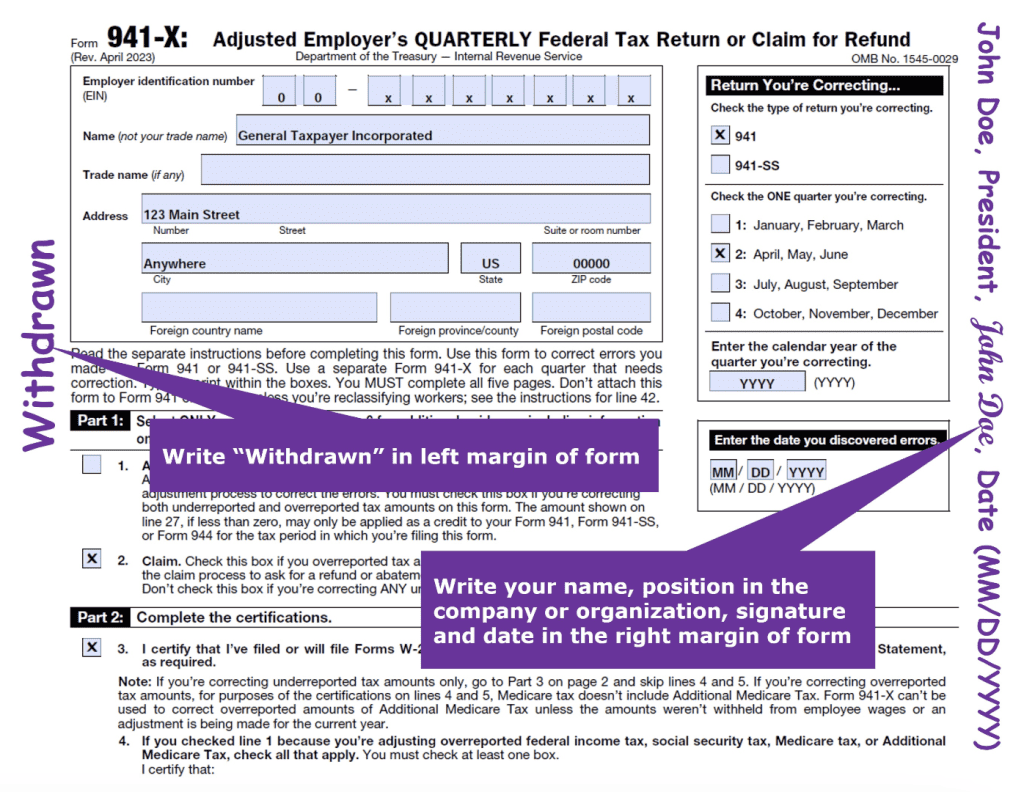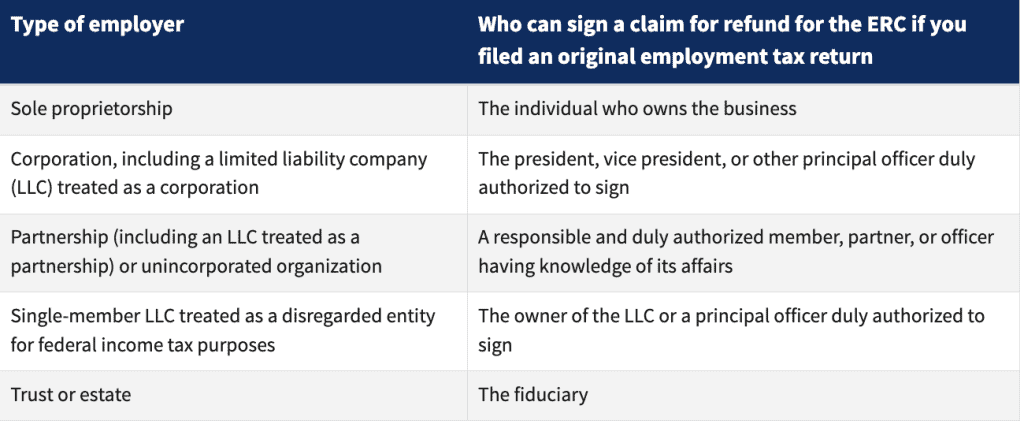
Level Up Your Business Today
Join the thousands of people like you already growing their businesses and knowledge with our team of experts. We deliver timely updates, interesting insights, and exclusive promos to your inbox.
Join For FreeIf you suspect your ERC claim was made inaccurately, the IRS will now allow businesses to withdraw claims to avoid penalties and fees.

On 11/14/23, IRS Commissioner Daniel Werfel announced that the IRS is updating its ERC review procedures and will begin processing new ERC claims in the near future following the moratorium implemented in September. Existing claims are still being processed and eligible businesses can still submit an ERC claim through reputable ERC specialists to be processed when the moratorium ends. Visit our full breakdown of the ERC pause for the latest information.
When the IRS announced the ERC pause on September 14, 2023, they alluded to adding an option to withdraw inaccurate or fraudulent claims. Now ERC withdrawal is here, but what does it mean? Should you withdraw your ERC claim?
Learn exactly what the IRS’s ERC claim withdrawal process is, how it works, and if and when you should withdraw your ERC claim.
Table of Contents
The employee retention tax credit is a complicated tax credit for COVID relief that certain businesses are eligible for. When properly claimed, the ERC is a great source of cash flow for businesses. When improperly claimed, a slew of problems can ensue.
Because of the prevalence of ERC scams, many taxpayers have unknowingly applied for the employee retention credit without actually being eligible for the credit. Some ERC scammers and untrustworthy third-party ERC companies have encouraged employers to apply for this credit without confirming that all requirements are met. Employers that fall into this bucket are left facing potential charges, investigations, and may be held responsible for repaying their entire ERC credit (which could be tens of thousands of dollars for some businesses).
The IRS saw such a rise in ERC scams and ineligible ERC claims that they paused processing all new ERC claims. When the IRS announced this pause, they also announced that there would be a way out for employers who have already filed for the ERC credit but now suspect or know that their claim is ineligible — that’s where the new IRS ERC withdrawal policy comes in.
One of the most important statements from the IRS explains exactly what the IRS ERC claim withdrawal policy is and how it works:
“Created the withdrawal option to help small business owners and others who were pressured or misled by ERC marketers or promoters into filing ineligible claims. Claims that are withdrawn will be treated as if they were never filed. The IRS will not impose penalties or interest. Those who willfully filed a fraudulent claim, or those who assisted or conspired in such conduct, should be aware that withdrawing a fraudulent claim will not exempt them from potential criminal investigation and prosecution.”
The most important things for small business owners to know about the ERC withdrawal policy are:
And most importantly of all, just because there is now a withdrawal policy doesn’t mean you have to use it. Do not withdraw your ERC claim if you are eligible for the employee retention credit!
This new policy shouldn’t scare business owners who meet all of the ERC requirements and qualifications. If you are eligible, then you should 100% take this credit and get the extra cash for your business.
Don’t let fears of ERC audits scare you either. Eligible businesses have nothing to worry about — the IRS wants eligible businesses to get their cash, too, so take a deep breath and take your ERC credit with confidence.
If you are worried that your ERC claim is inaccurate or ill-advised, we’ll lay out exactly what next steps you need to take.
In order to be eligible to withdraw an ERC claim, first, you need to verify that you are actually ineligible to claim the ERC credit by carefully reviewing the ERC eligibility requirements.
Then, you’ll need to meet the following ERC withdrawal requirements:
If you meet these requirements, then you can withdraw your ERC claim.
You should only withdraw your ERC claim if you don’t qualify for the ERC, filed an ERC claim in error, and want to withdraw your entire ERC credit amount.
If you qualify for the ERC credit, then you should not withdraw your claim. If you qualify for the ERC credit but made an error on the ERC claim and need to adjust the amount of your credit, you also should not withdraw your claim.
If you made an error on your amended tax return for your ERC claim, like calculating your ERC incorrectly, but you still qualify for the ERC credit, don’t withdraw your claim. Instead, amend your credit amount. Only withdraw your ERC claim if you aren’t eligible for the employee retention tax credit and want to withdraw the entire amount of your ERC credit.
The process for withdrawing your claim is going to depend on the status of your ERC claim. The steps will vary based on whether you haven’t received your refund and haven’t been notified that your claim is under audit, haven’t received your refund and have been notified that your claim is under audit, or have received your refund but haven’t cashed or deposited the funds yet.
Depending on your specific tax situation, follow the appropriate steps below to withdraw your ERC claim.
To withdraw your ERC claim, follow the following steps for each tax period that you filed a Form 941-X, 943-X, 944-X, or CT-1X for:

Source: Internal Revenue Service (IRS), screenshot captured 10/25/2023
Your withdrawal request can be signed by a duly authorized agent of the taxpayer or one of the following persons based on your business’s organization:

Source: Internal Revenue Service (IRS), screenshot captured 10/25/2023
If you can’t fax your withdrawal request, you can mail it to the IRS. Check the IRS’s official ERC withdrawal instructions for more information.
If you’ve been notified that your claim is under audit, you’ll do everything above except you won’t fax your withdrawal request. To withdraw your ERC claim, follow the following steps for each tax period that you filed a Form 941-X, 943-X, 944-X, or CT-1X for:
At the time of writing this post, voided ERC checks and withdrawal requests were being sent to:
Cincinnati Refund Inquiry Unit
PO Box 145500
Mail Stop 536G
Cincinnati, OH 45250
Please double-check the IRS’s official ERC withdrawal instructions to verify that this is still the most up-to-date mailing address before mailing any information to the IRS.
If you’ve received your ineligible ERC refund but haven’t cashed or deposited your check yet, first of all, don’t deposit or cash it!
You’ll do everything above except you won’t fax your withdrawal request. To withdraw your ERC claim, follow the following steps for each tax period that you filed a Form 941-X, 943-X, 944-X, or CT-1X for:
According to the IRS:
“If you use a professional payroll company and they filed your ERC claim for you, you should consult with them if you want to withdraw your ERC claim. Depending on how the company filed your claim — individually or batched with others — you may need to have them submit your withdrawal request.”
The same goes for if you filed with another type of tax preparer or ERC specialist — unless you suspect your ERC company was part of an ERC scam like a ghost preparer or ERC mill. If you are the victim of ERC fraud, withdraw your claim directly with the IRS and report the company using Form 14157, Complaint: Tax Return Preparer.
Learn about the signs of ERC ghost preparers and more on how to report ERC scams to the IRS.
After you withdraw your ERC claim, the IRS will reach out to you to confirm that your ERC claim withdrawal request has been approved with a letter. Once approved, the IRS says it’ll treat everything as if the claim never happened — so long as you haven’t knowingly and willingly participated in any criminal activity.
The IRS also won’t charge any penalties or interest for withdrawn ERC claims.
You may still have to amend your income tax return after your claim withdrawal request has been approved.
If it’s too late for you to withdraw your ERC request, but you know that the request is invalid and that you weren’t actually eligible for the employee retention credit, you may be faced with filing error penalties and/or held responsible for repaying the employee retention credit.
If you find yourself in this situation, reach out to a trusted tax professional right away. Also, pause any spending of your ERC refund if you haven’t used it yet so that you can cover any potential expenses that arise. And don’t forget to report any ERC scammers if you believe you are the victim of ERC fraud.
Get in touch with a real human being on the Merchant Maverick team! Send us your questions, comments, reviews, or other feedback. We read every message and will respond if you'd like us to.
Reach OutGet in touch with a real human being on the Merchant Maverick team! Send us your questions, comments, reviews, or other feedback. We read every message and will respond if you'd like us to.
Reach Out
Let us know how well the content on this page solved your problem today. All feedback, positive or negative, helps us to improve the way we help small businesses.
Give Feedback
Want to help shape the future of the Merchant Maverick website? Join our testing and survey community!
By providing feedback on how we can improve, you can earn gift cards and get early access to new features.
Help us to improve by providing some feedback on your experience today.
The vendors that appear on this list were chosen by subject matter experts on the basis of product quality, wide usage and availability, and positive reputation.
Merchant Maverick’s ratings are editorial in nature, and are not aggregated from user reviews. Each staff reviewer at Merchant Maverick is a subject matter expert with experience researching, testing, and evaluating small business software and services. The rating of this company or service is based on the author’s expert opinion and analysis of the product, and assessed and seconded by another subject matter expert on staff before publication. Merchant Maverick’s ratings are not influenced by affiliate partnerships.
Our unbiased reviews and content are supported in part by affiliate partnerships, and we adhere to strict guidelines to preserve editorial integrity. The editorial content on this page is not provided by any of the companies mentioned and has not been reviewed, approved or otherwise endorsed by any of these entities. Opinions expressed here are author’s alone.